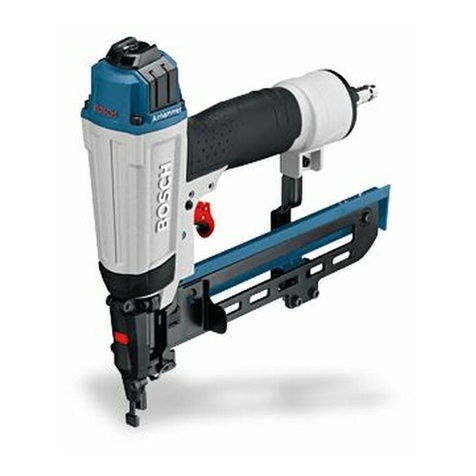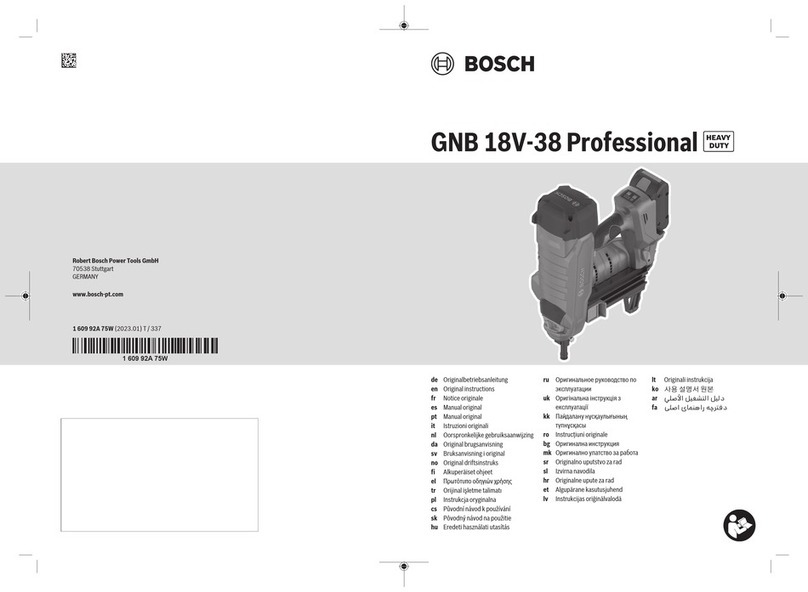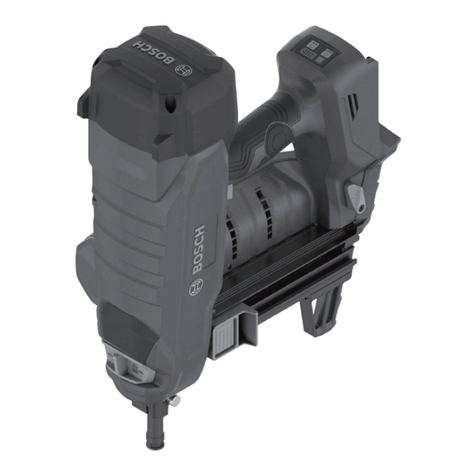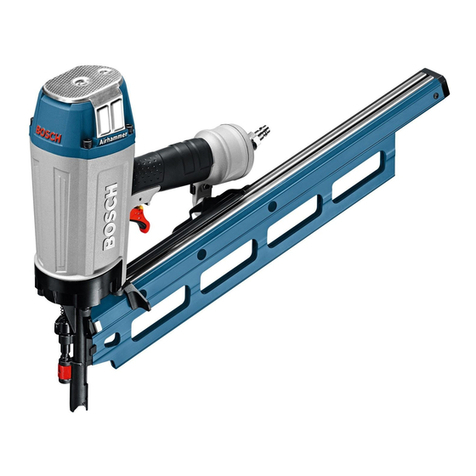
English | 15
Bosch Power Tools 1 609 929 X29 | (25.3.11)
Personal safety
fStay alert, watch what you are doing, and use common sense when
operatingapneumatic tool. Donot usea pneumatictool whiletired
or under the influence of drugs, alcohol, or medication. A moment
of inattention while operating a pneumatic tool may result in personal
injury.
fUse personal protective equipment. Always wear eye protection.
Protective equipment such as dust mask, non-skid safety shoes, hard
hat, or hearing protection used for appropriate conditions will reduce
personal injuries.
fPrevent unintentional starting. Make sure that the pneumatic tool
is switched off before connecting it to the air supply, picking it up
or carrying it. When your finger is on the On/Off switch while carrying
the pneumatic tool or when connecting the pneumatic tool to the air
supply while it is switched on, accidents can occur.
fRemove any adjustment tools before switching on the pneumatic
tool.Awrenchor key left attached to a rotatingpartof a pneumatictool
may result in personal injury.
fDo not overreach. Keep proper footing and balance at all times.
This enables better control of the pneumatic tool in unexpected situa-
tions.
fDress properly. Do not wear loose clothing or jewellery. Keep your
hair, clothing and gloves away from moving parts. Loose clothes,
jewellery or long hair can be caught in moving parts.
fIf devices are provided for the connection of dust extraction and
collection facilities, ensure these are connected and properly
used. Use of dust collection can reduce dust-related hazards.
fDo not directly inhale the exhaust air. Avoid exposing the eyes to
exhaust air. The pneumatic tool’s exhaust air can contain water, oil,
metal particles and debris from the compressor. This can cause dam-
age to one‘s health.
Pneumatic tool use and care
fUse the clamping devices or a vice to secure and support the work-
piece. Holding the workpiece by hand or against your body will not al-
low for safe operation of the pneumatic tool.
fDonot overload the pneumatic tool. Use the pneumatictool intend-
ed for your work. The correct pneumatic tool will do the job better and
safer at the rate for which it is designed.
fDo not use a pneumatic tool that has a defective On/Off switch. A
pneumatic tool that cannot be controlled with the switch is dangerous
and must be repaired.
fDisconnect the air supply before making any adjustments, chang-
ing accessories, or placing the pneumatic tool aside. This safety
measure prevents accidental starting of the pneumatic tool.
fStoreidlepneumatictoolsoutof thereachof children.Donot allow
personsunfamiliarwiththepneumatictool orthese instructionsto
operate the device. Pneumatic tools are dangerous in the hands of un-
trained users.
fMaintain the pneumatic tool with care. Check for misalignment or
bindingofmoving parts,breakageof partsand anyothercondition
that may affect the pneumatic tool’s operation. Have damaged
parts repaired before using the pneumatic tool. Many accidents are
caused by poorly maintained pneumatic tools.
fUsethepneumatic tool, accessories, application tools,etc.accord-
ing to these instructions. Take into consideration the working con-
ditions andthe activitiesto be carriedout. Useof the pneumatic tool
for operations different from those intended could result inhazardous
situations.
Service
fHave your pneumatic tool repaired only through a qualified repair
person and only using original replacement parts. This will ensure
that the safety of the pneumatic tool is maintained.
Safety Warnings for Compressed-air Nailers/Staplers
Wear safety goggles.
fAlways assume that the pneumatic tool is loaded with fasteners.
Careless handling of the pneumatic tool can lead to unexpected shot
actuation of fasteners and cause injury.
fWhen working, hold the pneumatic tool in such a manner that your
head and body cannot be injured in case of sudden kickback dueto
a malfunction of the energy supply or from hard objects/locations
in the workpiece.
fNever point the pneumatic tool at yourself or at persons close by.
Unexpected actuation will expel a fastener, which can lead to injury.
fDo not actuate the pneumatic tool until firmly placed against the
workpiece. When the pneumatic tool is not in contact with the work-
piece, the fastener can bounce away from the fastening point and over-
load the pneumatic tool.
Donot workonladdersor scaffolds when theactuation
system “Contact actuation” is set. In particular, do not
move from one fastening location to another, close
boxes or enclosures, or fasten transport-securing fix-
tures on e.g., vehicles and waggons, via scaffolds, stairs, ladders or
ladder-like constructions, such as roof battens. With this actuation
system, a fastener will be discharged each time when accidentally apply-
ing the pneumatic tool while the discharge lock-off is pressed in. This can
lead to injury.
fObserve the conditions of the job site. It is possible that fasteners
can burst through thin workpieces or be deflected when working in cor-
ners or against edges, and harm persons.
Disconnect the air supply, when the fastener is
jammed in the pneumatic tool. When the pneumatic tool
is still connected to the power supply, it can accidentally
be actuated when removing a jammed fastener.
fUse caution when removing a jammed or stuck fastener. The sys-
tem can be under tension and cause the fastener to be shot or thrust
out, while attempting to clear the jam.
fDo not usethis topneumatic tool tofasten electricalwiring. Itis not
suitable for fastening electrical wiring, can damage the insulation of
electric cables and thus lead to electric shock and danger of fire.
fNever use oxygen or flammable gases as the energy source for the
pneumatic tool. Flammable gases aredangerous and can cause the
pneumatic tool to explode.
fUseappropriatedetectorstodetermineifutilitylinesare hiddenin
the work area or call the local utility company for assistance. Con-
tact with electric lines can lead to fire and electric shock. Damaging a
gas line can lead to explosion. Penetrating a water line causes property
damage or may cause an electric shock.
fThe pneumatic tool may only be connected to lines, for which the
maximal permissible pressure of the pneumatic tool cannot be ex-
OBJ_BUCH-1303-001.book Page 15 Friday, March 25, 2011 11:07 AM


















































